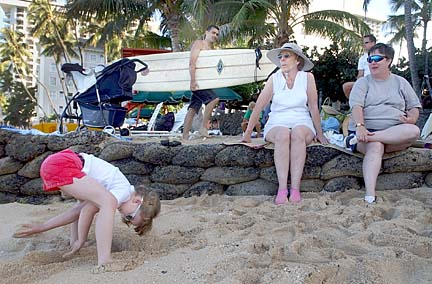
ASSOCIATED PRESS
Marian Metzger, 6, of Deluth, Ga., digs in the sand near a breaking wall on Waikiki Beach as her grandmother Selma and mother, Sarah, right, sit nearby.
Time and tide erode
beach sand in Waikiki
Millions of tourists have voyaged across the Pacific just to spread their beach towel on a patch of Waikiki's warm, inviting sand.
Trouble is, there's not as much of it as there used to be.
Waikiki's world-famous white sand beaches have been eroding an average of one foot a year since 1985, experts say. And as the shoreline shrinks and reefs fill with the sand moving offshore, many say it's time to protect the key asset of Hawaii's famed tourist strip.
"The fundamental problem is that we haven't maintained the resource," said Chip Fletcher, a professor of coastal geology at the University of Hawaii. "If we're going to insist on having a beach there, we've got to keep putting a fresh coat of paint on it."
Famed for its luxury hotels and carefree surfers, Waikiki -- the prized stretch of sand between Diamond Head, Honolulu's most recognizable natural feature, and the public boat harbor -- is, without fail, crowded with locals and visitors alike.
It was artificially widened three generations ago in anticipation of such popularity, but officials have done little over the years to maintain its plus-size status.
Now, after years of wrangling, state lawmakers included $700,000 in the state budget that took effect Tuesday to widen a sun-soaked expanse of Waikiki called Kuhio Beach. But even taking into account an estimated $1 million allocated by the federal government over the last three years, the funds will hardly put a dent in the cost of full sand replenishment along Waikiki.
Samuel Lemmo, senior planner of the state Office of Conservation and Coastal Lands, says the price tag is up to $25 million to fix the entire length of Waikiki.
"It's way overdue," said state Rep. Galen Fox (R, Waikiki), whose district includes Waikiki. "We very much need sand."
Originally a narrow sandy strip, Waikiki grew from less than a half-mile long in 1925 to about 1.5 miles long today, according to Fletcher.
Over the years, truckloads of sand were brought in. Rumors are rampant on its origin, from Australia to Molokai. Sand importation -- common at beaches throughout the world -- largely stopped in the early '70s.
And for all the sand brought in, Fletcher estimates some 100,000 cubic yards has receded into the Pacific since 1951 -- filling in reefs, creating shallower water and changing the way the surf breaks.
"It's very disappointing to see the small amount of sand left," said Robert Finley, chairman of the Waikiki Neighborhood Board, which has lobbied for sand replenishment.
It's likely few Waikiki sunbathers notice much wrong with the beach or water. But aficionados who have made Waikiki's beaches a part of their life, either through their work or recreation, say the area has seen significant changes.
"Waikiki is such a unique spot that when you start to fill the reef contours, the wave takes on a different personality," said George Downing, vice president of Save our Surf, an advocacy group focusing on coastal issues.
Some small projects aside, little has been done in the last three decades to restore Waikiki's sand volume. After more than 20 years out of the public eye, the issue motivated a number of studies in the early to mid-1990s.
While some money is now set aside for Kuhio Beach and perhaps other sections of the shoreline, no definitive project is on the horizon, and even smaller undertakings are likely years away.
Lemmo said completing environmental impact statements and acquiring permits could keep use of allotted funds three or more years away.
Still, what concerns many is what method will be chosen when sand replenishment eventually occurs. Officials could choose to truck in sand to add to beaches, as has been done in the past. Or, as many are urging, sand that has receded into the water could be pumped back to the beach.
"We're opposed to them bringing in sand from other venues," said Downing, who was a beach boy in Waikiki for more than three decades until the mid-'70s.
"The place to go ... is not to get new sand," said Fletcher, "it's to reclaim the sand that's been lost from the shore."
The sand was lost in the first place because of natural ocean movements, not overuse. Waves created by short, choppy tradewinds tend to erode the beach. Summer's large swells bring sand back in. The end result is a coastline that needs constant maintenance in order to keep a steady volume of sand.
"Waikiki is a man-made beach," said Lemmo. "If you're going to build something, if you're going to create something, you've got to care for it."
